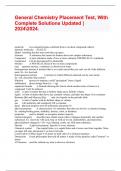Ionization energy ie - Study guides, Class notes & Summaries
Looking for the best study guides, study notes and summaries about Ionization energy ie? On this page you'll find 37 study documents about Ionization energy ie.
Page 2 out of 37 results
Sort by

-
UWorld MCAT QBank Questions Missed Exam Questions And Answers
- Exam (elaborations) • 7 pages • 2024
-
- $11.49
- + learn more
UWorld MCAT QBank Questions Missed Exam Questions And Answers Paramagnetic - answerUnpaired electrons in the electronic configuration of an atom or ion, which end up interacting with each other in a magnetic field Diamagnetic - answerPaired electrons in the electronic configuration of an atom or ion, which will NOT interact with each other in a magnetic field Electron capture - answerAn alternative form of positron emission (B^+ decay) Reactivity of forming Ionic Bonds - answerThis increa...

-
UWorld MCAT QBank Questions Missed Exam Questions And Answers
- Exam (elaborations) • 7 pages • 2024
-
- $11.49
- + learn more
UWorld MCAT QBank Questions Missed Exam Questions And Answers Paramagnetic - answerUnpaired electrons in the electronic configuration of an atom or ion, which end up interacting with each other in a magnetic field Diamagnetic - answerPaired electrons in the electronic configuration of an atom or ion, which will NOT interact with each other in a magnetic field Electron capture - answerAn alternative form of positron emission (B^+ decay) Reactivity of forming Ionic Bonds - answerThis increa...

-
UWorld MCAT QBank Questions Missed Exam Questions And Answers
- Exam (elaborations) • 7 pages • 2024
-
- $11.49
- + learn more
UWorld MCAT QBank Questions Missed Exam Questions And Answers Paramagnetic - answerUnpaired electrons in the electronic configuration of an atom or ion, which end up interacting with each other in a magnetic field Diamagnetic - answerPaired electrons in the electronic configuration of an atom or ion, which will NOT interact with each other in a magnetic field Electron capture - answerAn alternative form of positron emission (B^+ decay) Reactivity of forming Ionic Bonds - answerThis increa...

-
General Chemistry Placement Test, With Complete Solutions Updated | 20242024.
- Exam (elaborations) • 8 pages • 2024
- Available in package deal
-
- $12.89
- + learn more
General Chemistry Placement Test, With Complete Solutions Updated | 20242024. molecule two nonmetal atoms combined form a covalent compound called a diatomic molecules H2,O2,F2 Matter Anything that has mass and takes up space Element A substance that cannot be broken down into simpler substances Compound A pure substance made of two or more elements CHEMICALLY combined. Compound Can be decomposed by chemically Mixture A PHYSICAL blend of two or more components (aq) aqueous mi...

-
Chem120/ chem 120 exam-guide highly recommended
- Exam (elaborations) • 7 pages • 2024
- Available in package deal
-
- $11.29
- + learn more
Chem 120 exam guide highly recommended Degenerate Degenerate orbitals = 2+ orbitals w/equal energy (ex= 2p) -One electron goes into each degenerate orbital before any pairing occurs Requires energy 1s-> 2s requires energy -energy levels are dictated by principle quantum number (n) -need more energy for an electron to move away from the nucleus -energy levels get closer together as they increase in quantum number Orbitals B/c 2s and 2p orbitals have the same principal quant...

-
Chemistry Praxis Exam Questions And Answers (Updated And Verified)
- Exam (elaborations) • 7 pages • 2024
-
- $11.49
- + learn more
Chemistry Praxis Exam Questions And Answers (Updated And Verified) Chemical periodicity - answerThe variation in properties of elements with their positions in the periodic table Periods in the periodic table - answerPeriods: Rows which run horizontally. Labeled with a number: 1, 2, 3, 4, 5, 6, 7. These numbers indicate the total number of energy levels that any element in this period will have. For example, K (potassium) which is found in period 4, has 4 energy levels when diagrammed. ...

-
Chemistry Praxis Exam Questions And Answers (Updated And Verified)
- Exam (elaborations) • 7 pages • 2024
-
- $11.49
- + learn more
Chemistry Praxis Exam Questions And Answers (Updated And Verified) Chemical periodicity - answerThe variation in properties of elements with their positions in the periodic table Periods in the periodic table - answerPeriods: Rows which run horizontally. Labeled with a number: 1, 2, 3, 4, 5, 6, 7. These numbers indicate the total number of energy levels that any element in this period will have. For example, K (potassium) which is found in period 4, has 4 energy levels when diagrammed. ...

-
Chem 210 Exam 1 2023(solved)
- Exam (elaborations) • 7 pages • 2023
-
Available in package deal
-
- $16.99
- + learn more
Molarity moles of solute/liters of solution mole fraction moles of A/total moles solute + moles solvent mass percentage mass of solute/mass of solution x 100% mass of solution solute+solvent ppm mass of solute/mass of solution x 10^6 ppb mass of solute/mass of solution x 10^9 volume percentage vol of component/total volume x 100 molality moles of solute/kg of solvent ** denominator does not include mass of solute Ionization Energy The amount of...

-
Chemistry Praxis Exam Questions And Answers (Updated And Verified)
- Exam (elaborations) • 7 pages • 2024
-
- $11.49
- + learn more
Chemistry Praxis Exam Questions And Answers (Updated And Verified) Chemical periodicity - answerThe variation in properties of elements with their positions in the periodic table Periods in the periodic table - answerPeriods: Rows which run horizontally. Labeled with a number: 1, 2, 3, 4, 5, 6, 7. These numbers indicate the total number of energy levels that any element in this period will have. For example, K (potassium) which is found in period 4, has 4 energy levels when diagrammed. ...

-
Chem Lecture 6 Answers 2023 UPDATE RATED A+
- Exam (elaborations) • 9 pages • 2023
-
- $8.49
- + learn more
Chem Lecture 6 Answers 2023 UPDATE RATED A+ What is ionization energy? Ionization energy is defined as the energy required to remove an electron from a gaseous atom. What is the formula for ionization energy? X (g) + energy –> E+(g) + e- What are the periodic trends for IE? Horizontal: IE increases across a row of the periodic table (from left to right) Vertical: IE decreases down a group (column) of the periodic table (from top to bottom) As you go left to right horizontally, wh...

Did you know that on average a seller on Stuvia earns $82 per month selling study resources? Hmm, hint, hint. Discover all about earning on Stuvia


